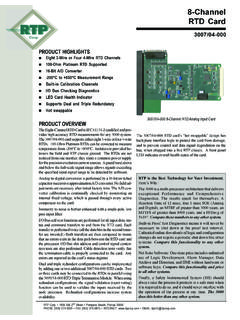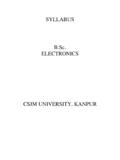Transcription of Atmel AVR ATtiny441/841 Summary Datasheet
1 8495HS AVR 05/2014 Features High Performance, Low Power Atmel AVR 8-bit Microcontroller Advanced RISC Architecture 120 Powerful Instructions Most Single Clock Cycle Execution 32 x 8 General Purpose Working Registers Fully Static Operation Up to 16 MIPS Throughput at 16 MHz Non-volatile Program and Data Memories 4/8K Bytes of In-System Programmable Flash Program Memory Endurance: 10,000 Write/Erase Cycles 256/512 Bytes of In-System Programmable EEPROM Endurance: 100,000 Write/Erase Cycles 256/512 Bytes Internal SRAM Data Retention: 20 Years at 85oC / 100 Years at 25oC Programming Lock for Self-Programming Flash & EEPROM Data Security Peripheral Features One 8-bit and Two 16-bit Timer/Counters with Two PWM Channels, Each Programmable Ultra Low Power Watchdog Timer 10-bit Analog to Digital Converter 12 External and 5 Internal, Single-ended input Channels 46 Differential ADC Channel Pairs with Programmable Gain (1x / 20x / 100x)
2 Two On-chip Analog Comparators Two Full Duplex USARTs with Start Frame Detection Master/Slave SPI Serial Interface Slave I2C Serial Interface Special Microcontroller Features Low Power Idle, ADC Noise Reduction, Standby and Power-down Modes Enhanced Power-on Reset Circuit Programmable Brown-out Detection Circuit with Supply Voltage Sampling External and Internal Interrupt Sources Pin Change Interrupt on 12 Pins Calibrated 8 MHz Oscillator with Temperature Calibration Option Calibrated 32kHz Ultra Low Power Oscillator High-Current Drive Capability on 2 I/O Pins I/O and Packages 14-pin SOIC, 20-pad MLF/QFN and 20-pad VQFN 12 Programmable I/O Lines Speed Grade 0 2 MHz @ 0 4 MHz @ 0 10 MHz @ 0 16 MHz @ Low Power Consumption Active Mode: mA at and 1 MHz Idle Mode: 30 A at and 1 MHz Power-Down Mode (WDT Enabled): A at Power-Down Mode (WDT Disabled): 150nA at AVR Microcontroller with 4/8K Bytes In-SystemProgrammable FlashSUMMARY DATASHEET2 ATtiny441/841 [ Summary Datasheet ]8495HS AVR 05 ConfigurationsFigure 1-1.
3 Pinout in 14-pin 1-2. Pinout in 20-pad (PCINT8/ADC11/XTAL1/CLKI) PB0(PCINT9/ADC10/XTAL2/INT0) PB1(PCINT11/ADC9/RESET/dW) PB3(PCINT10/ADC8/CLKO/TOCC7/ICP2/RXD0) PB2(PCINT7/ADC7/TOCC6/ICP1/TXD0/SS) PA7(PCINT6/ADC6/ACO1/TOCC5/XCK1/SDA/MOSI ) PA6 GNDPA0 (PCINT0/ADC0/AREF/MISO)PA1 (PCINT1/ADC1/AIN00/TOCC0/TXD0/MOSI)PA2 (PCINT2/ADC2/AIN01/TOCC1/RXD0/SS)PA3 (PCINT3/ADC3/AIN10/TOCC2/T0/XCK0/SCK)PA4 (PCINT4/ADC4/AIN11/TOCC3/T1/RXD1/SCL/SCK )PA5 (PCINT5/ADC5/ACO0/TOCC4/T2/TXD1/MISO)123 4515141312112019181716678910 NOTE Bottom pad should besoldered to : Do Not ConnectDNCDNCGNDVCCDNCPA7 (PCINT7/ADC7/TOCC6/ICP1/TXD0/SS)PB2 (PCINT10/ADC8/CLKO/TOCC7/ICP2/RXD0)PB3 (PCINT11/ADC9/RESET/dW)PB1 (PCINT9/ADC10/XTAL2/INT0)PB0 (PCINT8/ADC11/XTAL1/CLKI)PA5 (PCINT5/ADC5/ACO0/TOCC4/T2/TXD1/MISO)DNC DNCDNCPA6 (PCINT6/ADC6/ACO1/TOCC5/XCK1/SDA/MOSI)(P CINT4/ADC4/AIN11/TOCC3/T1/RXD1/SCL/SCK) PA4(PCINT3/ADC3/AIN10/TOCC2/T0/XCK0/SCK) PA3(PCINT2/ADC2/AIN01/TOCC1/RXD0/SS) PA2(PCINT1/ADC1/AIN00/TOCC0/TXD0/MOSI) PA1(PCINT0/ADC0/AREF/MISO) PA03 ATtiny441/841 [ Summary Datasheet ]8495HS AVR 05 input .
4 A low level on this pin for longer than the minimum pulse length will generate a reset, even if the clock is not running and provided the reset pin has not been disabled. Shorter pulses are not guaranteed to generate a reset pin can also be used as a (weak) I/O A (PA7:PA0)This is an 8-bit, bi-directional I/O port with internal pull-up resistors (selected for each bit). Output buffers have standard sink and source capability, except ports PA7 and PA5, which have high sink inputs, port pins that are externally pulled low will source current provided that pull-up resistors are activated. Port pins are tri-stated when a reset condition becomes active, even if the clock is not port has alternative pin functions for pin change interrupts, the analog comparator, and ADC. B (PB3:PB0)This is a 4-bit, bi-directional I/O port with internal pull-up resistors (selected for each bit).
5 Output buffers have standard sink and source inputs, port pins that are externally pulled low will source current provided that pull-up resistors are activated. Port pins are tri-stated when a reset condition becomes active, even if the clock is not port has alternative pin functions for pin change interrupts, and [ Summary Datasheet ]8495HS AVR 05 is a low-power CMOS 8-bit microcontrollers based on the AVR enhanced RISC architecture. By executing powerful instructions in a single clock cycle, the ATtiny441/841 achieves throughputs approaching 1 MIPS per MHz allowing the system designer to optimize power consumption versus processing 2-1. Block DiagramDEBUGINTERFACECALIBRATED ULPOSCILLATORWATCHDOGTIMERCALIBRATEDOSCI LLATORTIMING ANDCONTROLVCCRESETGND8-BIT DATA BUSPB[3:0]CPU COREPROGRAMMEMORY(FLASH)DATAMEMORY(SRAM) POWERSUPERVISION:PORBODRESETISPINTERFACE PORT APORT BVOLTAGEREFERENCEMULTIPLEXERANALOGCOMPAR ATORADCTEMPERATURESENSOR8-BITTIMER/COUNT ER16-BITTIMER/COUNTERTWO-WIREINTERFACEUS ARTEEPROMON-CHIPDEBUGGERPA[7:0]ANALOGCOM PARATOR16-BITTIMER/COUNTERUSART5 ATtiny441/841 [ Summary Datasheet ]8495HS AVR 05/2014 The AVR core combines a rich instruction set with 32 general purpose working registers.
6 All 32 registers are directly connected to the Arithmetic Logic Unit (ALU), allowing two independent registers to be accessed in a single instruction, executed in one clock cycle. The resulting architecture is compact and code efficient while achieving throughputs up to ten times faster than conventional CISC provides the following features: 4K/8K bytes of in-system programmable Flash 256/512 bytes of SRAM data memory 256/512 bytes of EEPROM data memory 12 general purpose I/O lines 32 general purpose working registers One 8-bit timer/counter with two PWM channels Two 16-bit timer/counters with two PWM channels Internal and external interrupts One 10-bit ADC with 5 internal and 12 external channels One ultra-low power, programmable watchdog timer with internal oscillator Two programmable USARTs with start frame detection Slave Two-Wire Interface (TWI) Master/slave Serial Peripheral Interface (SPI) Calibrated 8 MHz oscillator Calibrated 32kHz, ultra low power oscillator Four software selectable power saving device includes the following modes for saving power: Idle mode.
7 Stops the CPU while allowing the timer/counter, ADC, analog comparator, SPI, TWI, and interrupt system to continue functioning ADC Noise Reduction mode: minimizes switching noise during ADC conversions by stopping the CPU and all I/O modules except the ADC Power-down mode: registers keep their contents and all chip functions are disabled until the next interrupt or hardware reset Standby mode: the oscillator is running while the rest of the device is sleeping, allowing very fast start-up combined with low power consumptionThe device is manufactured using Atmel s high density non-volatile memory technology. The Flash program memory can be re-programmed in-system through a serial interface, by a conventional non-volatile memory programmer or by an on-chip boot code, running on the AVR ATtiny441/841 AVR is supported by a full suite of program and system development tools including: C compilers, macro assemblers, program debugger/simulators and evaluation [ Summary Datasheet ]8495HS AVR 05 comprehensive set of drivers, application notes, data sheets and descriptions on development tools are available for download at ExamplesThis documentation contains simple code examples that briefly show how to use various parts of the device.
8 These code examples assume that the part specific header file is included before compilation. Be aware that not all C compiler vendors include bit definitions in the header files and interrupt handling in C is compiler dependent. Please confirm with the C compiler documentation for more RetentionReliability Qualification results show that the projected data retention failure rate is much less than 1 PPM over 20 years at 85 C or 100 years at 25 values contained in this Datasheet are based on simulations and characterization of other AVR microcontrollers manufactured on the same process [ Summary Datasheet ]8495HS AVR 05 SummaryAddressNameBit 7 Bit 6 Bit 5 Bit 4 Bit 3 Bit 2 Bit 1 Bit 0 Page(s)(0xFF)Reserved (0xFE)Reserved (0xFD)Reserved (0xFC)Reserved (0xFB)Reserved (0xFA)Reserved (0xF9)Reserved (0xF8)Reserved (0xF7)Reserved (0xF6)Reserved (0xF5)Reserved (0xF4)Reserved (0xF3)Reserved (0xF2)Reserved (0xF1)Reserved (0xF0)Reserved (0xEF)Reserved (0xEE)
9 Reserved (0xED)Reserved (0xEC)Reserved (0xEB)Reserved (0xEA)Reserved (0xE9)Reserved (0xE8)Reserved (0xE7)Reserved (0xE6)Reserved (0xE5)Reserved (0xE4)Reserved (0xE3)Reserved (0xE2)Reserved (0xE1)Reserved (0xE0)Reserved (0xDF)Reserved (0xDE)Reserved (0xDD)Reserved (0xDC)Reserved (0xDB)Reserved (0xDA)Reserved (0xD9)Reserved (0xD8)Reserved (0xD7)Reserved (0xD6)Reserved (0xD5)Reserved (0xD4)Reserved (0xD3)Reserved (0xD2)Reserved (0xD1)Reserved (0xD0)Reserved (0xCF)Reserved (0xCE)Reserved (0xCD)Reserved (0xCC)Reserved (0xCB)Reserved (0xCA)TCCR2 ACOM2A1 COM2A0 COM2B1 COM2B0 WGM21 WGM20 Page 111(0xC9)TCCR2 BICNC2 ICES2 WGM23 WGM22CS22CS21CS20 Page 114(0xC8)TCCR2 CFOC2 AFOC2B Page 115(0xC7)TCNT2 HTimer/Counter2 Counter Register High BytePage 116(0xC6)TCNT2 LTimer/Counter2 Counter Register Low BytePage 116(0xC5)OCR2 AHTimer/Counter2 Output Compare Register A High BytePage 117(0xC4)OCR2 ALTimer/Counter2 Output Compare Register A Low BytePage 117(0xC3)OCR2 BHTimer/Counter2 Output Compare Register B High BytePage 117(0xC2)OCR2 BLTimer/Counter2 Output Compare Register B Low BytePage 117(0xC1)ICR2 HTimer/Counter1 input Capture Register High BytePage 118(0xC0)ICR2 LTimer/Counter1 input Capture Register Low BytePage 118(0xBF)Reserved 8 ATtiny441/841 [ Summary Datasheet ]8495HS AVR 05/2014(0xBE)Reserved (0xBD)Reserved (0xBC)Reserved (0xBB)Reserved (0xBA)Reserved (0xB9)Reserved (0xB8)
10 Reserved (0xB7)Reserved (0xB6)Reserved (0xB5)Reserved (0xB4)Reserved (0xB3)Reserved (0xB2)SPCRSPIESPEDORDMSTRCPOLCPHASPR1 SPR0 Page 157(0xB1)SPSRSPIFWCOL SPI2 XPage 158(0xB0)SPDRSPI Data RegisterPage 159(0xAF)Reserved (0xAE)Reserved (0xAD)Reserved (0xAC)Reserved (0xAB)Reserved (0xAA)Reserved (0xA9)Reserved (0xA8)Reserved (0xA7)Reserved (0xA6)Reserved (0xA5)TWSCRATWSHE TWDIETWASIETWENTWSIETWPMETWSMEPage 205(0xA4)TWSCRB TWHNMTWAATWCMD1 TWCMD0 Page 205(0xA3)TWSSRATWDIFTWASIFTWCHTWRATWCTWB ETWDIRTWASPage 207(0xA2)TWSATWI Slave Address RegisterPage 208(0xA1)TWSAMTWI Slave Address Mask RegisterTWAEPage 208(0xA0)TWSDTWI Slave Data RegisterPage 209(0x9F)Reserved (0x9E)Reserved (0x9D)Reserved (0x9C)Reserved (0x9B)Reserved (0x9A)Reserved (0x99)Reserved (0x98)Reserved (0x97)Reserved (0x96)UCSR1 ARXC1 TXC1 UDRE1FE1 DOR1 UPE1U2X1 MPCM1 Page 181, 193(0x95)UCSR1 BRXCIE1 TXCIE1 UDRIE1 RXEN1 TXEN1 UCSZ12 RXB81 TXB81 Page 182, 194(0x94)UCSR1 CUMSEL11 UMSEL10 UPM11 UPM10 USBS1 UCSZ11 UCSZ10 UCPOL1 Page 183, 195(0x93)UCSR1 DRXSIE1 RXS1 SFDE1 Page 185(0x92)UBRR1 HUSART1 Baud Register High BytePage 186, 196(0x91)UBRR1 LUSART1 Baud Rate Register Low BytePage 186, 196(0x90)UDR1 USART1 Data RegisterPages 180, 192(0x8F)Reserved (0x8E)Reserved (0x8D)Reserved (0x8C)Reserved (0x8B)Reserved (0x8A)Reserved (0x89)Reserved (0x88)Reserved (0x87)Reserved (0x86)UCSR0 ARXC0 TXC0 UDRE0FE0 DOR0 UPE0U2X0 MPCM0 Page 181, 193(0x85)













